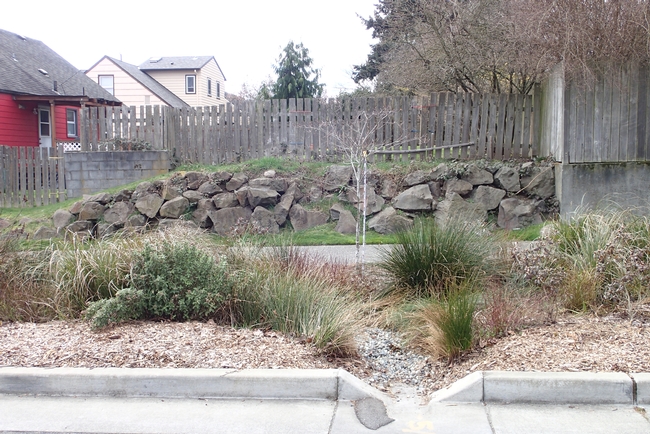UC to study the fate of street trees grown in increasingly popular bioswales
To keep pollution out of the ocean and natural creeks, California city planners are looking for creative ways to manage the large amount of water that falls during rain storms. More and more, they are building bioswales, shallow roadside basins designed to hold water as it slowly percolates into the soil or can be delivered to waste water treatment plants.
In many areas, the bioswales – sometimes called “rain gardens” or “stormwater planters” – are being beautifully designed and landscaped so that, in addition to addressing flood management, they provide an artful green oasis in the largely asphalt and concrete urban jungle. Ornamental trees are a common feature.
Street trees have shaded and beautified urban areas for centuries, but because the construction of bioswales is relatively new, little is known about managing trees in areas that are periodically flooded. Public works, flood control and transportation professionals have turned to a University of California Agriculture and Natural Resources (UC ANR) urban forestry expert for guidance.
“At this time, there is no information available about the fate of trees in bioswales,” said Igor Lacan, UC ANR Cooperative Extension environmental horticulture advisor in the San Francisco Bay Area. Lacan is a native of Croatia who immigrated to the U.S. as a teenager, then completed bachelor's and master's degrees in ecology, and a doctorate degree in urban forestry at UC Berkeley before joining UC ANR in 2013.
“The lack of information has raised concerns about the potential damage to the trees growing in bioswales and the potential damage to facilities from repeated removal and replanting of dead trees,” Lacan said.
The UC ANR California Institute for Water Resources this month announced a $25,000 grant to fund Lacan's study of the performance of ornamental trees – their survival, growth and health – planted in urban bioswales. Lacan plans to compare bioswales in the city of Portland, Ore., which has more than 10 years experience with this form of stormwater management, to projects in three California Cities – San Francisco, San José and El Cerrito. The project will include the development of a monitoring protocol so that commensurate information can be collected about trees in bioswales, and collection of the information in a database for city planners to access when they are making future bioswale planting decisions.
Lacan said he will also compare trees planted in stormwater facilities with trees of the same species and age planted as street trees. Tree size, condition and presence of insect pests or diseases will be noted and soil samples will be analyzed in a laboratory.
The partner cities are volunteering their involvement in the project.
“They recognize the important role trees play in their environments and the lack of information we now have on tree performance,” Lacan said. “I believe we'll sign up more partner cities as our work continues. San Francisco, San José and El Cerrito are pioneers.”
Data collection for the project begins in April 2015.
An initiative to improve California water quality, quantity and security is part of the UC Division of Agriculture and Natural Resources Strategic Vision 2025.
Author: Jeannette Warnert

A street corner where two uses of the parkstrip can be seen: a classic lawn-and-trees arrangement on the right, and a bioswale on the left. The bioswale incorporates trees, but their performance (growth and lifespan) in such habitats remains unknown.



Posted by Peter MacDonagh on April 15, 2015 at 4:01 PM